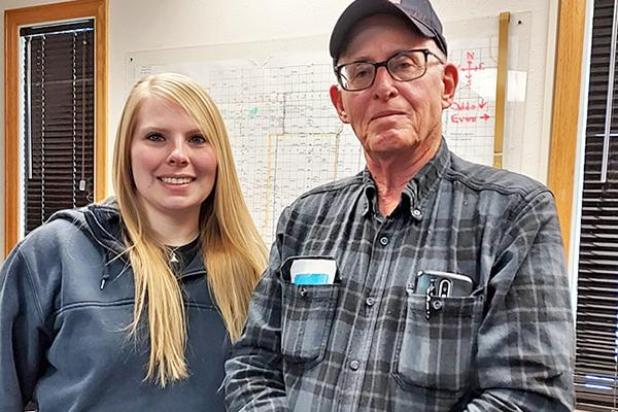
Sara Kumm, left, will become the next director of the Phillips County Communications Center on Feb. 1, following the retirement of Kenny Gaskill, right, on Jan. 31. Gaskill is leaving after 28 years of service at the center. — JR Krueger | For The Holyoke Enterprise
Phillips County Communications Center prepares for seamless change in directors
When Phillips County Communications Center Director Kenny Gaskill chose his retirement date of Jan. 31, he proactively designed a plan to ensure there would be no vacancy in the position before selecting the next director. He had the fortunate circumstance of having a qualified staff member, Sara Kumm, promotable from within the center. Her training was completed in time to assume the director’s position Feb. 1.
Gaskill began as a dispatcher in 1994. He had retired from the U.S. Army and, in his words, “just needed a job.” The center was completing the transition from being the Holyoke Information Center to the current Phillips County Communications Center. Callers soon would be unable to request phone numbers not yet available in the phone book. The sheriff was Scott McBee. Holyoke and Haxtun police chiefs were Berry Winkler and Tom Davis, respectively. Both the sheriff’s department and Holyoke police department were housed at the center. As is still today, it was staffed by five dispatchers, including the director. It served the same agencies then as it does now.
Gaskill became the director in December 1997, filling in behind the previous director, Darlene Johnson.
Given Gaskill’s exit from the center, The Holyoke Enterprise is capturing some of Gaskill’s institutional history and experience with the changes he’s helped implement throughout his 28-year tenure. In reflecting on what it takes to do the work and manage the center, he emphasized how much he appreciated all his past and present co-workers, first responders, and county government leaders who helped and supported him along the way.
Essential services core to public safety
To fully appreciate the role and function of the director and center, one must first understand the nature and function of the communications center. It plays a critical public safety and emergency service role that is largely taken for granted. A dispatcher has critical information and data at their fingertips to keep the general public and first responders safe and informed. The center receives calls from the public for fire and medical emergencies, and both emergency and non-emergency calls for law enforcement purposes. Police, fire and emergency medical service personnel are categorically referred to as first responders.
The center dispatches personnel from Holyoke and Haxtun police departments, and the Phillips County Sheriff’s Deptartment; from the Holyoke and the Haxtun ambulance services; and from the Holyoke, Haxtun, Amherst, Sandhills and Wages volunteer fire departments.
Additionally, dispatchers radio the Colorado State Patrol communication center to dispatch state troopers where needed. They can also phone on-duty or on-call rangers from the Colorado Parks and Wildlife Division. They reach the Colorado Department of Transportation by phone or through the State Patrol, who can radio Department of Transportation personnel. And they can phone or radio the National Weather Service.
Dispatchers can radio Colorado communications centers statewide and phone out-of-state counties. This is particularly helpful when situations like large fires require mutual aid from adjacent counties, or incidents like high-speed pursuits leave one jurisdiction and enter another.
The Unicom radio at the center allows pilots to announce take-offs and landings at the Holyoke airport, if they choose to. It’s used rather infrequently because, as Gaskill pointed out, “A lot of small planes don’t have radios.”
The center also operates the Emergency Alert Notification System. National Weather Service’s severe weather bulletins are an example of an alert.
Dispatchers also have computer access to the Colorado Crime Information Center managed by the Colorado Bureau of Investigation. That system works in tandem with the National Crime Information Center. The Colorado Crime Information Center database includes the Department of Revenue’s Motor Vehicle Division’s driver license and vehicle registration information. Both include certain crime-related information. This is how, for example, an officer handling a stopped vehicle finds out if the driver has an arrest warrant, the license is suspended or revoked, or the car is stolen.
The full article is available in our e-Edition. Click here to subscribe.
